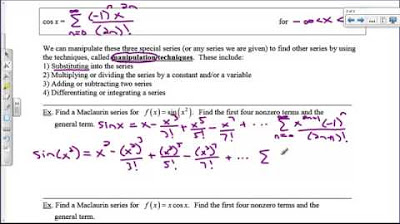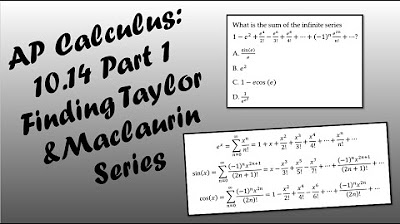Taylor Series Day 2
TLDRIn this educational video, the instructor explores Taylor series and their manipulation, focusing on the series for e^x, sin(x), and cosine(x). They demonstrate calculating limits using series expansion and derive the Taylor series for a function involving cosine(x). The video also covers approximating integrals using Taylor polynomials and ensuring the error is less than 1/500, showcasing the practicality and usefulness of Taylor series in mathematical analysis.
Takeaways
- 📚 The video focuses on the manipulation of power series, specifically the Taylor series for e^x, sin(x), and cosine(x), which are centered at zero.
- 🔢 The first four non-zero terms of the Taylor series for e^x are given, along with the general term formula involving increasing powers of x over n factorial.
- 🧩 The limit of (f(x) - 1) / (2x) as x approaches 0 is calculated using the Taylor series for e^x, resulting in a simplified expression and a final limit of 1/2.
- 📉 The Taylor series for cosine(x) is discussed, emphasizing the first four non-zero terms and the general term formula with alternating signs and even powers of x.
- 🔍 The script demonstrates how to find the Taylor series for a new function, g(x) = (1 - cos(x))/x^2, by manipulating the known cosine Taylor series.
- 📝 The process involves simplifying the expression by canceling terms and dividing by x^2, resulting in a new series with specific powers and alternating signs.
- 📐 The general term for the new series g(x) is derived, starting from n=1 to ensure the first term is a polynomial and not zero.
- 📊 The script explains the use of the Taylor polynomial to approximate the value of an integral, specifically ∫(0 to 1) (1 - cos(t))/t^2 dt.
- ⚖️ An approximation is sought where the error is less than 1/500, using the alternating series error bound to justify the number of terms needed for the approximation.
- 📈 The anti-derivative of the Taylor polynomial is calculated to determine the integral's value and to ensure the error is within the acceptable limit.
- 📝 The final integral approximation is provided, along with a justification that the error is less than 1/500, showcasing the practicality of using Taylor polynomials for approximations.
Q & A
What is the main topic discussed in the video script?
-The main topic discussed in the video script is the manipulation of power series, specifically the Taylor series for functions like e^x, sin(x), and cosine(x), and using them to find limits and approximate integrals.
What are the first four non-zero terms of the Maclaurin series for e^x?
-The first four non-zero terms of the Maclaurin series for e^x are 1, x, x^2/2!, and x^3/3!.
What is the general term of the Maclaurin series for e^x?
-The general term of the Maclaurin series for e^x is x^n / n!, where n is a positive integer.
How does the script use the Maclaurin series for e^x to find a limit as x approaches 0?
-The script simplifies the expression f(x) - 1/(2x) by canceling terms and then dividing by x, and then evaluates the limit as x approaches 0, resulting in the limit being 1/2.
What is the Maclaurin series for cosine(x), and how many terms are discussed in the script?
-The Maclaurin series for cosine(x) is 1 - x^2/2! + x^4/4! - x^6/6! + ..., and the script discusses the first four non-zero terms.
What is the general term of the Maclaurin series for cosine(x)?
-The general term of the Maclaurin series for cosine(x) is (-1)^n * x^(2n) / (2n)!, where n is a non-negative integer.
How is the Maclaurin series for g(x) = (1 - cos(x))/x^2 derived from the series for cosine(x)?
-The script derives the series for g(x) by subtracting the series for 1 - cos(x) and then dividing term by term by x^2, resulting in a series with terms like 1/(2!), -x^2/(4!), and so on.
What is the purpose of using the Maclaurin series to approximate the integral of 1 - cos(t)/t^2 from 0 to 1?
-The purpose is to simplify the integration process by using the Maclaurin series, which allows for easier integration of powers of x, and to ensure that the approximation error is less than 1/500.
How does the script ensure that the approximation error is less than 1/500?
-The script uses the alternating series error bound, which states that the error is less than the first omitted term. By evaluating the magnitude of the terms and ensuring they are less than 1/500, the script justifies the approximation.
What is the final approximation for the integral of 1 - cos(t)/t^2 from 0 to 1 using the Maclaurin series?
-The final approximation is obtained by integrating the first two terms of the Maclaurin series, resulting in an approximation of 35/72, with an error less than 1/500.
Outlines
📚 Introduction to Power Series Manipulation
This paragraph introduces the topic of power series manipulation, specifically focusing on the Maclaurin series for e^x, sin(x), and cos(x). The speaker emphasizes the importance of knowing the first four non-zero terms of the Maclaurin series for e^x and provides the general term formula. The paragraph also sets up a problem to find the limit of a function as x approaches 0 using algebraic manipulation of the power series for e^x.
🔍 Detailed Analysis of Power Series Limit
The speaker proceeds with a detailed analysis of the limit problem set up in the previous paragraph. They simplify the expression by canceling terms and dividing by x, then evaluate the limit as x approaches 0. The result is a simple fraction, 1/2, which is the limit of the given function. The speaker also introduces the Maclaurin series for cos(x), providing the first four non-zero terms and the general term, and sets up a new problem to find the Maclaurin series for a related function g(x).
📉 Approximation Using Taylor Polynomials
In this paragraph, the speaker discusses the use of Taylor polynomials for approximation, specifically for the integral of 1 - cos(x)/x^2 from 0 to 1. They derive the Taylor series for the function and simplify it by dividing through by x^2. The speaker then calculates the integral of the Taylor polynomial and justifies the number of terms needed to ensure the approximation error is less than 1/500. They conclude with the approximate value of the integral and the assurance that the error is within the specified tolerance.
Mindmap
Keywords
💡Taylor Series
💡Maclaurin Series
💡e^x
💡sin(x)
💡cos(x)
💡General Term
💡Limit
💡Factorial
💡Alternating Series
💡Error Bound
Highlights
Introduction to the manipulation of Taylor series and the importance of knowing the series for e^x, sin(x), and cosine(x) centered at zero.
Practice of recalling the first four non-zero terms and the general term for the Taylor series of e^x.
Simplification of the limit as x approaches 0 of f(x) - 1/2x using algebraic manipulation of the power series.
Cancellation of terms and simplification leading to the limit result of 1/2.
Memorization of the first four non-zero terms and the general term for the cosine(x) Taylor series.
Finding the Taylor series for g(x) = 1 - cosine(x)/x^2 and providing the first four non-zero terms and the general term.
Explanation of the process to approximate the value using Taylor polynomials instead of the original function for integration.
Demonstration of how to calculate the integral of the Taylor series and the importance of the alternating series error bound.
Derivation of the anti-derivative for the Taylor series approximation and the calculation of the integral from 0 to 1.
Justification of the number of terms needed in the Taylor series to ensure the error is less than 1/500.
Final calculation of the integral and the assurance that the error is less than the first omitted term.
Conclusion on the approximation of the integral using Taylor polynomials and the confidence in the accuracy of the result.
Emphasis on the practicality and usefulness of Taylor polynomials in solving complex problems.
Anticipation of continuing the discussion in the next session.
Transcripts
5.0 / 5 (0 votes)
Thanks for rating:





